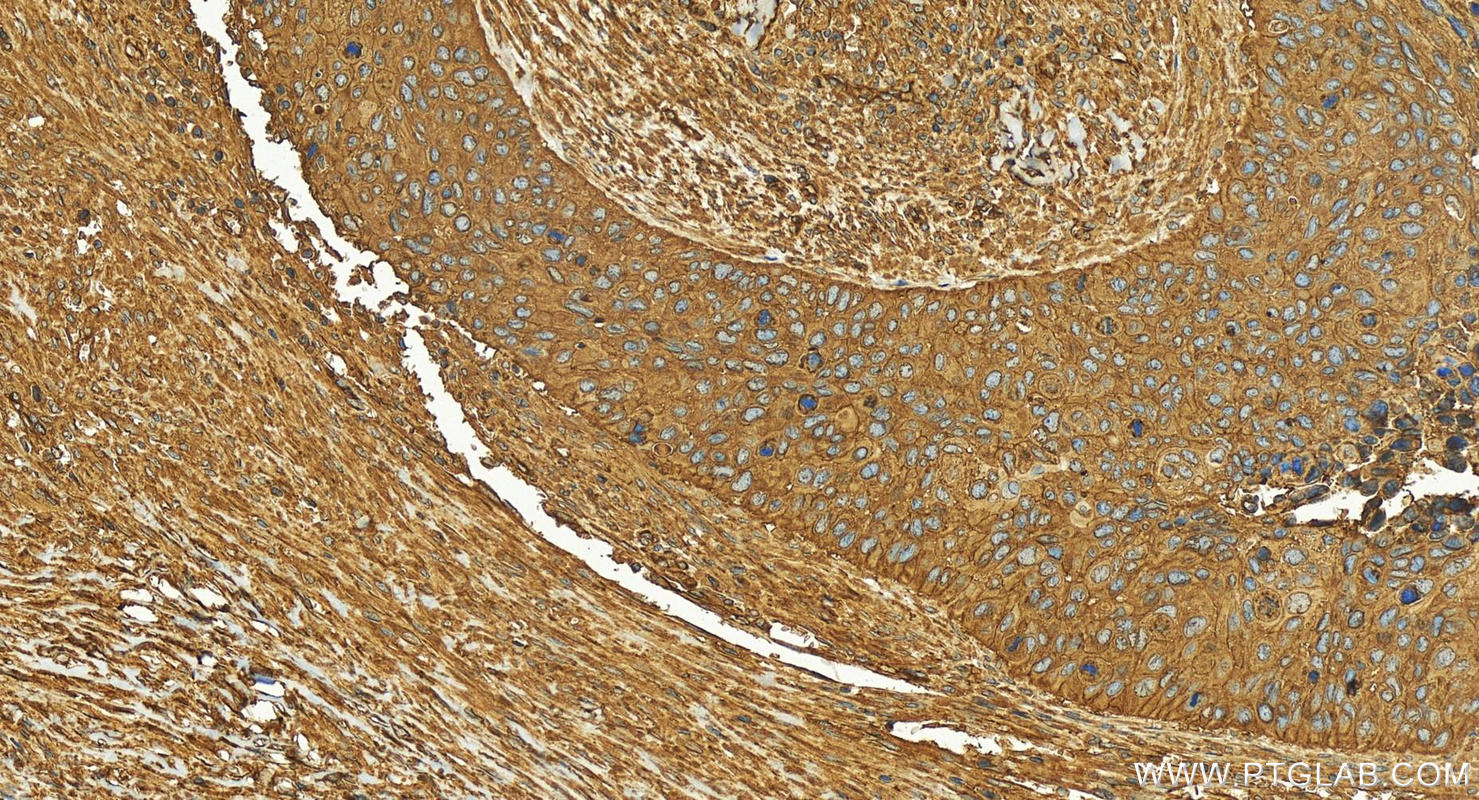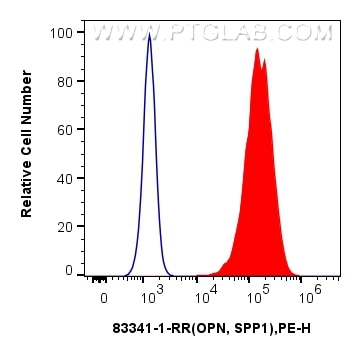Anticorps Recombinant de lapin anti-Osteopontin
Osteopontin Recombinant Antibody for WB, IHC, IF/ICC, FC (Intra), ELISA
Hôte / Isotype
Lapin / IgG
Réactivité testée
Humain, souris
Applications
WB, IHC, IF/ICC, FC (Intra), ELISA
Conjugaison
Non conjugué
CloneNo.
240206A2
N° de cat : 83341-1-RR
Synonymes
Galerie de données de validation
Applications testées
| Résultats positifs en WB | cellules MOLT-4, cellules HEK-293, cellules HepG2 |
| Résultats positifs en IHC | human cervical squamous cancer tissue, il est suggéré de démasquer l'antigène avec un tampon de TE buffer pH 9.0; (*) À défaut, 'le démasquage de l'antigène peut être 'effectué avec un tampon citrate pH 6,0. |
| Résultats positifs en IF/ICC | cellules RAW 264.7, |
| Résultats positifs en FC (Intra) | cellules U-937, cellules A549 |
Dilution recommandée
| Application | Dilution |
|---|---|
| Western Blot (WB) | WB : 1:1000-1:6000 |
| Immunohistochimie (IHC) | IHC : 1:200-1:800 |
| Immunofluorescence (IF)/ICC | IF/ICC : 1:125-1:500 |
| Flow Cytometry (FC) (INTRA) | FC (INTRA) : 0.25 ug per 10^6 cells in a 100 µl suspension |
| It is recommended that this reagent should be titrated in each testing system to obtain optimal results. | |
| Sample-dependent, check data in validation data gallery | |
Applications publiées
| WB | See 1 publications below |
| IF | See 2 publications below |
Informations sur le produit
83341-1-RR cible Osteopontin dans les applications de WB, IHC, IF/ICC, FC (Intra), ELISA et montre une réactivité avec des échantillons Humain, souris
| Réactivité | Humain, souris |
| Réactivité citée | Humain, souris |
| Hôte / Isotype | Lapin / IgG |
| Clonalité | Recombinant |
| Type | Anticorps |
| Immunogène | Protéine recombinante |
| Nom complet | secreted phosphoprotein 1 |
| Masse moléculaire calculée | 314 aa, 35 kDa |
| Poids moléculaire observé | 60-66 kDa |
| Numéro d’acquisition GenBank | BC007016 |
| Symbole du gène | Osteopontin |
| Identification du gène (NCBI) | 6696 |
| Conjugaison | Non conjugué |
| Forme | Liquide |
| Méthode de purification | Purification par protéine A |
| Tampon de stockage | PBS with 0.02% sodium azide and 50% glycerol |
| Conditions de stockage | Stocker à -20°C. Stable pendant un an après l'expédition. L'aliquotage n'est pas nécessaire pour le stockage à -20oC Les 20ul contiennent 0,1% de BSA. |
Informations générales
Osteopontin (OPN), also known as SPP1, is a secreted glycophosphoprotein that belongs to the small integrin-binding ligand N-linked glycoprotein (SIBLING) family. Originally isolated from bone, OPN has been found in kidneys, vascular tissues, biological fluids, and various tumor tissues (PMID: 15138464; 16406521). OPN can interact with CD44 and integrins and regulate diverse biological processes. It has a multifaceted role in bone development and remodeling, and is also involved in the inflammatory and immune response, oncogenesis and cancer progression. The very acidic nature of OPN, as well as the presence of variable posttranslational modifications, has led to anomalous migration in SDS-polyacrylamide gels and therefore to reports of different molecular weights for OPN (PMID: 8293561). Depending on the cell and tissue source and/or the SDS-PAGE system, OPN migrates with a molecular weight of 44-80 kDa, as well as at some smaller bands corresponding to peptide fragments (PMID: 8195113; 17890765).
Protocole
| Product Specific Protocols | |
|---|---|
| WB protocol for Osteopontin antibody 83341-1-RR | Download protocol |
| IHC protocol for Osteopontin antibody 83341-1-RR | Download protocol |
| IF protocol for Osteopontin antibody 83341-1-RR | Download protocol |
| Standard Protocols | |
|---|---|
| Click here to view our Standard Protocols |
Publications
| Species | Application | Title |
|---|---|---|
J Gastroenterol Single-cell RNA sequencing and functional analysis reveal the role of altered glycosylation levels of hepatic macrophages in liver cirrhosis | ||
Tissue Cell GIT2 negatively regulates the NF-κB pathway directly or indirectly by regulating TRAF3 expression to promote osteogenic differentiation of BMSCs |








